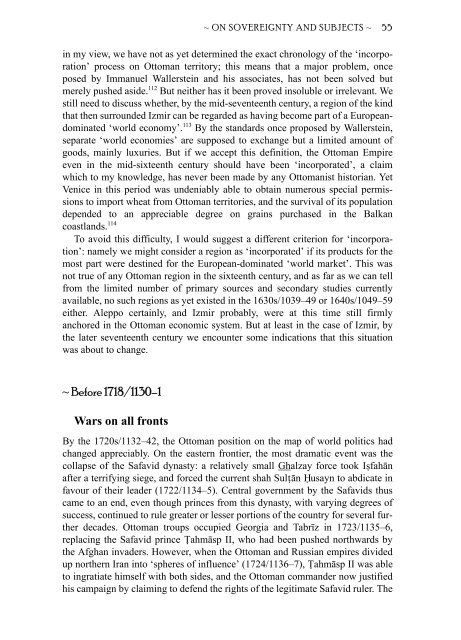The Ottoman Empire and the World Around It - Course Information
The Ottoman Empire and the World Around It - Course Information
The Ottoman Empire and the World Around It - Course Information
Create successful ePaper yourself
Turn your PDF publications into a flip-book with our unique Google optimized e-Paper software.
~ ON SOVEREIGNTY AND SUBJECTS ~ 55<br />
in my view, we have not as yet determined <strong>the</strong> exact chronology of <strong>the</strong> ‘incorporation’<br />
process on <strong>Ottoman</strong> territory; this means that a major problem, once<br />
posed by Immanuel Wallerstein <strong>and</strong> his associates, has not been solved but<br />
merely pushed aside. 112 But nei<strong>the</strong>r has it been proved insoluble or irrelevant. We<br />
still need to discuss whe<strong>the</strong>r, by <strong>the</strong> mid-seventeenth century, a region of <strong>the</strong> kind<br />
that <strong>the</strong>n surrounded Izmir can be regarded as having become part of a Europe<strong>and</strong>ominated<br />
‘world economy’. 113 By <strong>the</strong> st<strong>and</strong>ards once proposed by Wallerstein,<br />
separate ‘world economies’ are supposed to exchange but a limited amount of<br />
goods, mainly luxuries. But if we accept this definition, <strong>the</strong> <strong>Ottoman</strong> <strong>Empire</strong><br />
even in <strong>the</strong> mid-sixteenth century should have been ‘incorporated’, a claim<br />
which to my knowledge, has never been made by any <strong>Ottoman</strong>ist historian. Yet<br />
Venice in this period was undeniably able to obtain numerous special permissions<br />
to import wheat from <strong>Ottoman</strong> territories, <strong>and</strong> <strong>the</strong> survival of its population<br />
depended to an appreciable degree on grains purchased in <strong>the</strong> Balkan<br />
coastl<strong>and</strong>s. 114<br />
To avoid this difficulty, I would suggest a different criterion for ‘incorporation’:<br />
namely we might consider a region as ‘incorporated’ if its products for <strong>the</strong><br />
most part were destined for <strong>the</strong> European-dominated ‘world market’. This was<br />
not true of any <strong>Ottoman</strong> region in <strong>the</strong> sixteenth century, <strong>and</strong> as far as we can tell<br />
from <strong>the</strong> limited number of primary sources <strong>and</strong> secondary studies currently<br />
available, no such regions as yet existed in <strong>the</strong> 1630s/1039–49 or 1640s/1049–59<br />
ei<strong>the</strong>r. Aleppo certainly, <strong>and</strong> Izmir probably, were at this time still firmly<br />
anchored in <strong>the</strong> <strong>Ottoman</strong> economic system. But at least in <strong>the</strong> case of Izmir, by<br />
<strong>the</strong> later seventeenth century we encounter some indications that this situation<br />
was about to change.<br />
~ Before 1718/1130–1<br />
Wars on all fronts<br />
By <strong>the</strong> 1720s/1132–42, <strong>the</strong> <strong>Ottoman</strong> position on <strong>the</strong> map of world politics had<br />
changed appreciably. On <strong>the</strong> eastern frontier, <strong>the</strong> most dramatic event was <strong>the</strong><br />
collapse of <strong>the</strong> Safavid dynasty: a relatively small Ghalzay force took Is. fahān<br />
after a terrifying siege, <strong>and</strong> forced <strong>the</strong> current shah Sult. ān H. usayn to abdicate in<br />
favour of <strong>the</strong>ir leader (1722/1134–5). Central government by <strong>the</strong> Safavids thus<br />
came to an end, even though princes from this dynasty, with varying degrees of<br />
success, continued to rule greater or lesser portions of <strong>the</strong> country for several fur<strong>the</strong>r<br />
decades. <strong>Ottoman</strong> troups occupied Georgia <strong>and</strong> Tabrīz in 1723/1135–6,<br />
replacing <strong>the</strong> Safavid prince T. ahmāsp II, who had been pushed northwards by<br />
<strong>the</strong> Afghan invaders. However, when <strong>the</strong> <strong>Ottoman</strong> <strong>and</strong> Russian empires divided<br />
up nor<strong>the</strong>rn Iran into ‘spheres of influence’ (1724/1136–7), T.<br />
ahmāsp II was able<br />
to ingratiate himself with both sides, <strong>and</strong> <strong>the</strong> <strong>Ottoman</strong> comm<strong>and</strong>er now justified<br />
his campaign by claiming to defend <strong>the</strong> rights of <strong>the</strong> legitimate Safavid ruler. <strong>The</strong>


